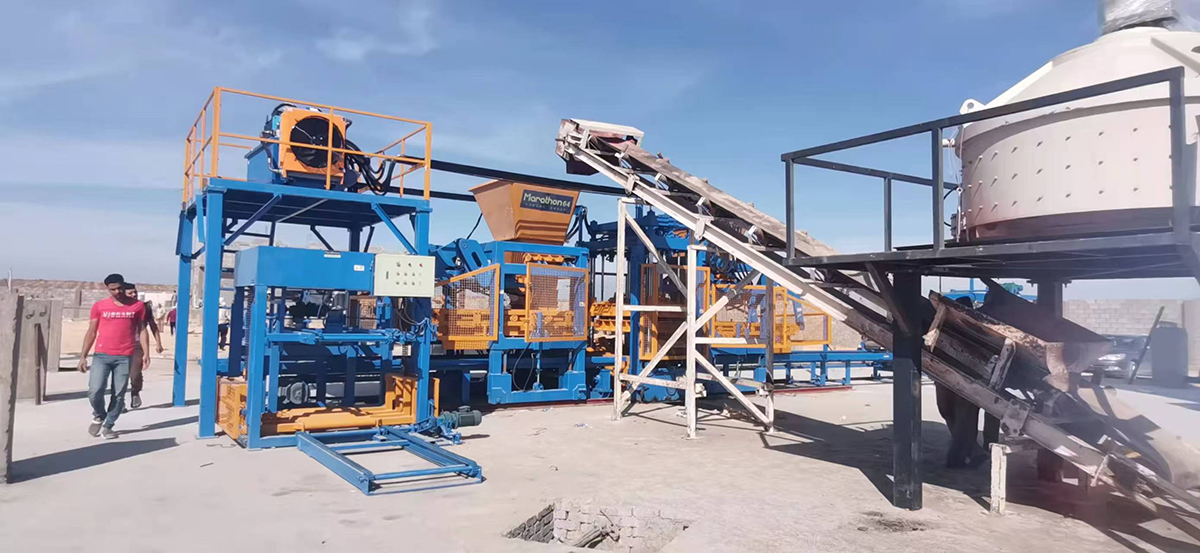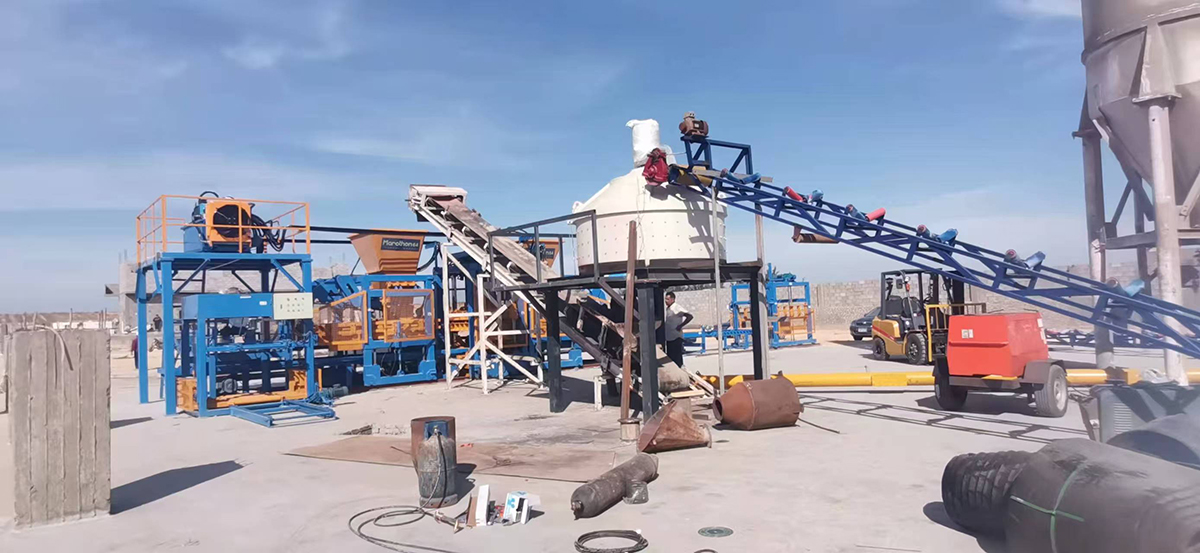The picture shows a non-fired brick machine production line. The following is a description from aspects such as equipment composition, working process, and application advantages:

Equipment Composition
• Main machine: As the core, it undertakes the key process of material pressing. Its molds can be replaced as needed to produce brick products of different specifications and shapes, such as standard bricks, hollow bricks, slope protection bricks, etc., to meet diverse construction needs. The frame is sturdy, ensuring the stable transmission of pressing force and the uniform compactness of the brick body.
• Batching system: Precisely controls the material proportioning and consists of a storage bin, a feeding device, etc. For raw materials such as cement, aggregates (such as sand and gravel), and fly ash, it is accurately conveyed through the feeding device according to the preset formula to ensure the stable performance of the brick body in terms of strength, durability, etc.
• Mixing system: Fully mixes various raw materials. The mixing main machine is equipped with appropriate mixing blades and rotation speed to uniformly mix the materials in the mixing drum to form a mixture with good plasticity, laying a foundation for subsequent forming and avoiding brick quality defects caused by uneven mixing.
• Conveying system: Relying on equipment such as belt conveyors, it connects various processes, conveys the batched and mixed materials to the main machine for forming, and also transfers the formed brick blanks to the curing area through it, ensuring continuous and smooth production and improving overall efficiency.
• Curing facilities (not fully shown in the picture, a key link in the production line): Commonly, there are natural curing areas or steam curing kilns. Natural curing relies on the ambient temperature and humidity for slow hardening; steam curing accelerates the strength growth of brick blanks by controlling temperature, humidity, and time, shortens the production cycle, and is especially suitable for large-scale and tight-schedule production.
Working Process
First, the batching system proportionally prepares raw materials such as cement, sand and gravel, and industrial waste residues (such as fly ash, slag), and sends them to the mixing system for full mixing to form a qualified mixture; then the conveying system sends the mixture to the main machine, and the main machine uses processes such as hydraulics and vibration to perform high-pressure pressing or vibration forming, so that the mixture forms a brick blank in the mold; after that, the brick blank is transported to the curing facility through the conveying system to complete the hardening process, and finally becomes a non-fired brick that meets the strength standards and can be put into use.
Application Advantages
• Environmental protection and energy saving: No sintering is required, reducing the large amount of energy consumption and exhaust gas (such as sulfur dioxide, dust) emissions caused by the firing of traditional sintered bricks. It can also effectively utilize industrial waste residues to realize the resource utilization of waste, meeting the development needs of green buildings.
• Controllable cost: The raw materials are extensive, and local sand and gravel, industrial waste can be used, reducing procurement costs; the non-sintering process shortens the production cycle, reduces equipment energy consumption and labor costs, and has significant economic benefits in long-term operation.
• Diverse products: By replacing molds, standard bricks, porous bricks, permeable bricks, etc. can be flexibly produced, adapting to different scenarios such as building masonry, road paving, and landscape construction, and having strong market adaptability.
• Stable quality: The mechanized production accurately controls the raw material proportioning, forming pressure, and curing conditions. The brick body has high strength and dimensional accuracy, and its flexural and compressive properties are better than some traditional sintered bricks, ensuring the quality of construction projects.
This type of non-fired brick machinery production line, with characteristics such as environmental protection, high efficiency, and flexibility in modern building materials production, has gradually become an important equipment for the upgrading and transformation of the brick-making industry, helping to realize the sustainable utilization of resources and the green development of the construction industry. If you want to have an in-depth understanding of a specific equipment or detail of the production line, you can provide additional explanations.
The picture shows a non-fired brick machine production line, which is the core equipment in the brick-making process. The following is an introduction from aspects such as the equipment's appearance and functional modules:
In terms of appearance, the main body of the equipment is mainly a blue frame structure, matched with orange components, and the layout is compact and regular. The blue frame plays a supporting role, being stable and reliable, and can withstand the forces of processes such as material pressing and conveying during production. The key components such as the orange material storage and forming parts are prominent against the blue background, facilitating operation and maintenance.
In terms of functional modules, there is a material storage unit, which is used to store raw materials such as cement, sand and gravel, and industrial waste residues to ensure continuous material supply. The batching system will accurately control the proportion of various raw materials according to the preset formula to ensure the stable performance of the brick body. The mixing module fully mixes the raw materials, and through appropriate mixing blades and rotation speed, the materials form a mixture with good plasticity, laying a foundation for the forming of brick blanks.
The forming main machine is the key. With the help of hydraulic and vibration processes, it performs high-pressure pressing or vibration forming on the mixture. The molds can be flexibly replaced, and it can produce brick products of different specifications and styles such as standard bricks, porous bricks, and permeable bricks, meeting various needs such as building masonry and road paving. The formed brick blanks are transferred to the curing area through the conveying system. Natural curing relies on ambient temperature and humidity for hardening, while steam curing accelerates strength growth by controlling temperature, humidity, and time, shortening the production cycle.
The non-fired brick machine production line is environmentally friendly and energy-saving. It does not require sintering, reducing the energy consumption and waste gas emissions of traditional firing, and can also consume industrial waste residues. In terms of cost, the raw materials are extensive, the process is short, and the energy consumption and labor costs are low. Due to mechanized control, the product quality has high strength and dimensional accuracy, helping the green and efficient development of the construction industry and playing a significant role in the modern brick-making field.
Post time: Jul-24-2025

 +86-13599204288
+86-13599204288
